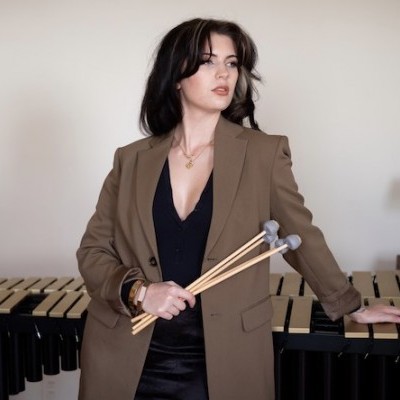Jun 3, 2025 11:25 AM
In Memoriam: Al Foster, 1943–2025
Al Foster, a drummer regarded for his fluency across the bebop, post-bop and funk/fusion lineages of jazz, died May 28…

Guitarist Raphael Roginski has performed as a solo artist, in duos and in numerous ensembles.
(Photo: Wieslaw Szuminski, from Raphael Roginski’s Facebook page)Polish guitarist Raphael Roginski discusses creativity with the same type of idiosyncratic, poetic aesthetic informs his stunning music.
“I recognized that playing an instrument should be like playing on veins or your hair,” he said. “It must be part of your body. Most of my guitar sounds are like an instrument made from ribs and veins.”
Through the use of different tuning systems and a largely self-taught practice that privileges scrabbling tangles of notes over familiar melodic flow, Roginski indisputably makes his guitar sound like something other than a conventional instrument.
When he was a young boy, his grandmother gave him a traditional spike fiddle, known as a kemenche.
“It was to make my dreams come true,” he said, referring to his grandmother’s gift and his childhood desire to own a guitar. “This gesture is still the basis for my music, how to create culture.”
Before eventually picking up an actual guitar, Roginski approached the kemenche like it was a guitar, eschewing the traditional bow and developing a singular style wherein melodies where shaped in gnarled clusters.
He first started reaching fans outside of Poland through his work in jazz-related ensembles, such as Hera, a wide-ranging internationally flavored ensemble led by clarinetist Waclaw Zimpel, and Shofar, a wildly careening trio with fire-breathing saxophonist Mikolaj Trzaska that brought a free-jazz intensity to traditional Jewish music, particularly nigunim.
But his music reaches much further, whether he’s playing art-rock in Wovoka, instrumental surf music in Alte Zachen or moody, richly atmospheric post-klezmer with the wonderful Cunfukt. In each context his playing stands out, just as it did in more jazz-related settings. In Hera he injected a brooding intensity that articulated melodies in a bizarrely non-linear fashion that made each solo an adventure.
In recent years, however, Roginski has distinguished himself through a series of recordings that mix solo performances and duets with a handful of distinctive female singers. Since 2015 he’s made three albums for the Bolt label’s Populista series, reinventing music by John Coltrane, baroque composer Henry Purcell, and obscure folk songs of Kurpie people from the Mazovia region of Poland. There are moments where a listener can’t miss a familiar Purcell air or a melodic phrase from “Countdown,” but by and large Roginski has made the music all his own.
He feels that the connective tissue for all of his work is the blues. “Around the world, the blues helped people cross traumas, problems,” he said. “So this also proves that you don’t need to be in the Mississippi Delta to be in the blues stream.”
He explained that his love for jazz came from listening to jazz icon Jim Hall, which reminded him of the sound of guitar-playing in Russian cinema.
Although Roginski blanches at categorizing the music he makes himself, he also views the work of some of his musical heroes as antithetical to genre. “I don’t know if my ‘jazz’ masters like Phil Cohran, Albert Ayler and Henry Threadgill are still in jazz,” he said. “I think it’s a different tradition—that’s more like new folk.
“I was born as a refugee in Germany,” Roginski continued. “My father was Jewish and my mother a mix of Tatar and Uzbeki, so part of my childhood was a very weird reality, like Chinatown mixed with Fiddler on the Roof,” he said with a laugh.
Roginski is a searcher who has traveled widely, absorbing sights and sounds and reaching for new connections. His language may be improvisation, but he refuses to be bound by a single dialect. “I would improvise with a Macedonian drummer more than jazz improv musicians,” he said. “We artists have a mission to be people free from cultural borders. You should breathe all of the air in the world. It’s not hard.”
(For information on the album Raphael Roginski Plays John Coltrane And Langston Hughes, African Mystic Music, visit the Bolt website. The Wexler Oral History Project at the Yiddish Book Center has posted a YouTube video of Roginski improvising on acoustic guitar. To see it, click here.) DB

Foster was truly a drummer to the stars, including Miles Davis, Sonny Rollins and Joe Henderson.
Jun 3, 2025 11:25 AM
Al Foster, a drummer regarded for his fluency across the bebop, post-bop and funk/fusion lineages of jazz, died May 28…

“Branford’s playing has steadily improved,” says younger brother Wynton Marsalis. “He’s just gotten more and more serious.”
May 20, 2025 11:58 AM
Branford Marsalis was on the road again. Coffee cup in hand, the saxophonist — sporting a gray hoodie and a look of…

“What did I want more of when I was this age?” Sasha Berliner asks when she’s in her teaching mode.
May 13, 2025 12:39 PM
Part of the jazz vibraphone conversation since her late teens, Sasha Berliner has long come across as a fully formed…

Roscoe Mitchell will receive a Lifetime Achievement award at this year’s Vision Festival.
May 27, 2025 6:21 PM
Arts for Art has announced the full lineup for the 2025 Vision Festival, which will run June 2–7 at Roulette…

Benny Benack III and his quartet took the Midwest Jazz Collective’s route for a test run this spring.
Jun 3, 2025 10:31 AM
The time and labor required to tour is, for many musicians, daunting at best and prohibitive at worst. It’s hardly…